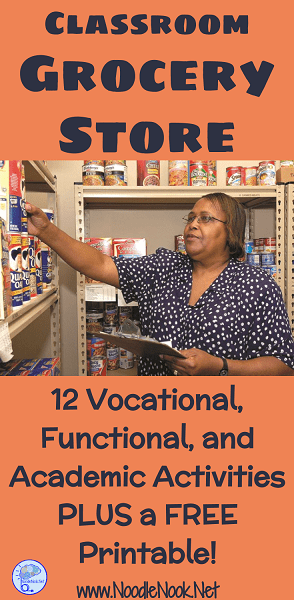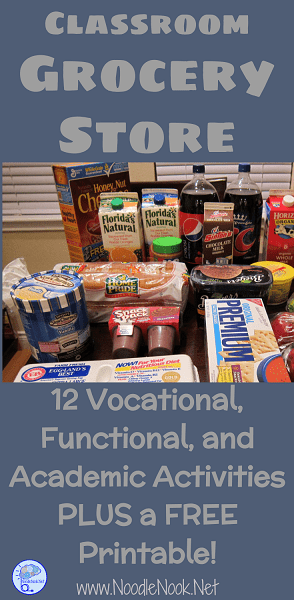Activities for a Grocery Store in Your Autism Classroom
Functional hands-on activities are perfect for Autism Units and Functional Learning Classrooms- they literally can serve so many purposes. When it comes to setting one up and building activities around it, here’s some tips and tricks on Vocational and Functional Activities for a Grocery Store in Your Autism Classroom!

[dt_gap height=”10″ /]
Vocational Activities for a Classroom Grocery Center
Once you have your class grocery store set up (which we will talk more about later), you have several options of activities your students can do. The ones that are most like authentic vocational tasks are:
- Facing/Stocking Shelves.
Remove all the items from a section of your grocery store and have the students restock the items. When we talk about setup below, you can see how labeling sections of your shelf will really come in handy). - Inventory
Students can use multiple supports to complete this (like a ten frame or tally system), but the general idea is the same. They will find a specific item, count how many of that specific item there are, and then report/record it. - Order Fulfillment
With so many places like Walmart, grocery stores, and even smaller brick and mortar stores setting up online order fulfillment, being able to find items and fill an order is becoming a real job skill. Once you have your store set up, make a shopping list (with pictures, words, or both) so students can practice locating certain items and then bagging them too.
[dt_gap height=”10″ /]
Functional Activities for a Classroom Grocery Store
Even if you are working on vocational skills with your students, you can also work on multiple functional skills on the path towards independence. With so many of our classrooms made up of multiple skill levels, it helps to have a variety of activities to tailor to student needs. With functional skills in mind, here are a few grocery activities:
- Meal Planning
Telling students to work through the process of deciding on a meal, making a grocery list, and then shopping in the store for the items needed is a very complex multi-step independent living skill. Focus in on a certain meal, like breakfast, snack, or pack lunch to give students some direction. - Price Comparison
As you label items in your classroom with prices, think about setting different price points for similar items, just like in the grocery store. This will allow students the opportunity to price shop. You can also make this more complex by adding coupons to the mix, which will change the price your student compares. Easy differentiation. - Shopping on a Budget
With all the items appropriately priced, have students shop with a specific budget in mind. What would they buy with only $10 for an entire meal? What about $30 for all their needs for a week? Can they set their own budget and then keep within the price point they’ve set.
[dt_gap height=”10″ /]
Academic Activities for a Classroom Grocery Center
Not only are vocational and functional activities for a grocery store a great way to build real and useful skills, but you can also use the same area as a center for academic tasks as well. If you have a grocery store center already set up in your classroom, consider adding these academic activities in Math:
- Estimating Totals while Shopping
While shopping from a list or in general, have students estimate what the total will be for the items they’ve selected- we all do this as a very functional skill in the store. At the end of the estimation, have students calculate the actual total, and then find the difference between the two. - Adding/Subtracting
Basic addition and subtraction is a hallmark to having a grocery store center. What better and more realistic activity is there? To make the activity more complex to differentiate for student needs, consider adding and coupons or discounts so that students have to do multi-step calculations. - Making Change from Total
Once students are finish calculating their total, identify a specific amount of money they will use to pay (like a 20 or 5) and task them with calculating what their change should be. You can also practice this skill as an estimation activity. - One Up Math with Running Totals
Most people use one up math to calculate what their total will be as they shop. Using your classroom grocery store center, you can easily set up the same type of activity or students use one up math. Allow them to do this with one, two, or more items as a way of differentiating for student needs.
[dt_gap height=”10″ /]
Here are a few ideas 4 grocery store center activities in English:
- Reading/Filling Recipe
Have students find a recipe, read the recipe, and then grocery shop for items they need to make the recipe within the grocery store. If you’re able to get items of multiple sizes, students can also determine what size works best for their needs. - Making a Shopping List
Students can write a shopping list and then use that list to find items in the grocery store center. This builds on a very functional skill of list making as well as incorporating writing and reading. You can use a grocery store flyer as a visual support for this activity, and may even want to try these Grocery Store flyer task cards.
[dt_gap height=”10″ /]
Setting Up Your Classroom Grocery Store
So now that you have a ton of great ideas and activities to do once you set up your grocery store, how do you get it all started?
- The first step will be asking for empty containers and boxes. Always had really great success asking students to bring in items from home. What that means is you will build a grocery store with the items your students actually eat and will likely shop for. if you are still coming up shorts, ask staff in your building to bring in empty containers. That is a sure fire way to fill your store fast! Remember, you want things that are cardboard based or plastics that can be easily washed. Steer clear of empty cans do to sharp edges as well as items that come in plastic wrap that cannot be easily washed. The last thing you want to do is invite critters into your classroom by way of your grocery store.
- Step two will be to give some heft to your packages. As you’re requesting empty containers, also ask for old newspapers and unneeded grocery bags. As you receive grocery store products, stuff them with crumpled-up newspaper or wadded-up grocery bags before you take the tops or glue the tops close. Empty cereal boxes tip over so easily… adding some stuffing will make them more stable and easier to work with. It is also great to have some bags handy so students can practice bagging the groceries in their vocational center.
- Now that you have some groceries and they aren’t tipping over, step 3 is to label them with prices. You can grab Circle stickers from the dollar store and easily label using those. Or, to make them a little bigger and prettier, try using this free principal price label. just attach it with tape. as you go to price the products in your store, remember to differentiate based on your student needs. You may want to do some whole dollar pricing so students can participate in the academic tasks at level appropriate for their skills. I suggest printing the price tags on 2 different colors so that you can tell students which color prices to use to be appropriate for their needs. You can put the text side by side or on different sides of the items, depending on what works for you.
- The last step, once all your grocery shelves are filled, is to label those shelves with either the specific items or the general categories. As students stock the shelves or even shop from their grocery list, having those general labels will help guide them through the process. The categories you decide to use for those labels will depend largely on what items are actually on your shelves, so take stock of your supply before you create your labels.
Putting It All Together
That is it, a quick list of 12 easy vocational and functional activities for a grocery store in your autism classroom. So, before you even get distracted, click ABOVE to get a printable list of the 12 activities along with a note you can send home today with students to start gathering items for your classroom grocery store! With the first step done, you will be well on your way!
Good Luck and Teach On!




I am in the process of setting up my classroom grocery center and the activities provided here have been beneficial. Very practical activities for students with Autism Spectrum Disorder and students who are moderately Intellectual Disabled. Love it!
Comments are closed.